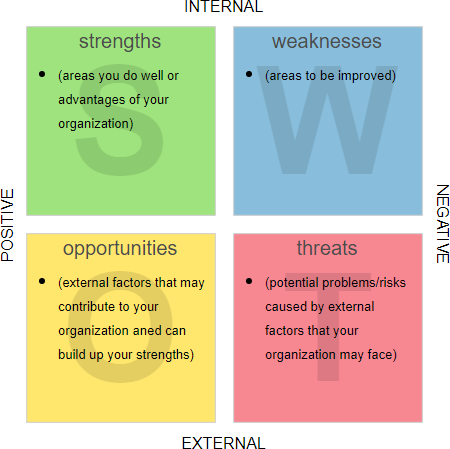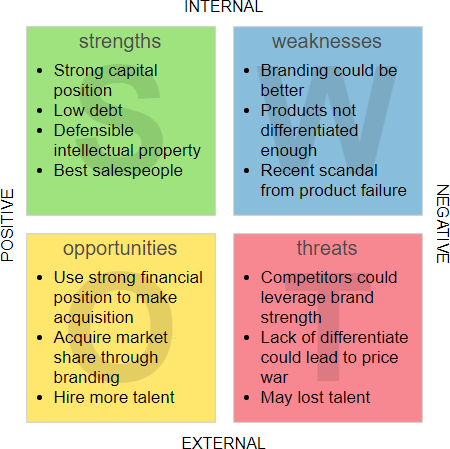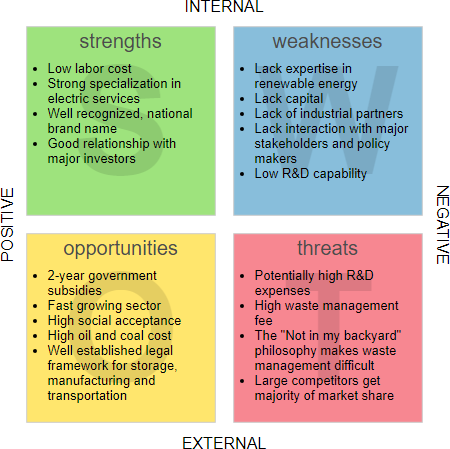SWOT Analysis Tutorial
Darwin's theory of evolution tells us: "There is a struggle for survival between creatures, the fitter survives, and the discomfort is eliminated. This is the natural choice. It is through genetics, variation and natural selection, from low to high, from simple to biological. Complex, species evolved and developed from less to more." The "battle between living creatures" is similar to the competitive relationship between companies and their competitors. They live together under the same blue sky, seize the same market together, and fight each other for survival. "Adapters survive, and those who are unfit are eliminated."
Changes in the external environment have a great impact on the product, and those who do not adapt to changes will be eliminated. What survives under the laws of nature is not the strongest, nor the smartest, but the most adaptable to environmental changes. How to adapt to changes in the environment and increase their resistance and immunity requires understanding both the status of the company's products and the changes in the external environment of the product.
What is SWOT Analysis?
Is there any way for companies to understand the changes in the product environment? SWOT analysis is often used for strategic decision-making by enterprises. In the strategic planning, SWOT should be regarded as a commonly used analysis method, Strength - competitive advantage, Weakness - disadvantage, Opportunity, Threat.

Advantages and disadvantages are the internal factors of the company (products), which are affected by factors such as product quality, materials, personnel, machines, channels, and services. Opportunities and threats are the external factors of the company (products) and are affected by the market, economy, society, and policies. The analysis of SWOT guides organizations to identify the advantages, disadvantages, opportunities, and threats of the product. Only by better understanding oneself, understanding the opponent, and understanding the environment can one remain more adaptive and responsive to the changes faster and better.
SWOT Analysis at a glance
The figure below shows a simple SWOT Analysis example.

SWOT Analysis - Key Concepts
Internal Factors - Strength and Weakness
- Strength: The ability of a company to surpass its competitors, or a company's unique advantage of improving competitiveness.
- Weakness: An area where an enterprise does not perform well or has failed to do so compared with its competitors, thereby placing itself at a disadvantage compared with its competitors.
The advantages and disadvantages of the product can be analyzed through the following perspectives:
The SW analysis mainly analyzes the comparison between the product's internal environment and competing products in these possible areas of: Quality, Price, Process, Capability, Sales/Services
- Quality
- Product quality safety, stability, reliability, aesthetics, applicability, durability, economy, etc.
- Price
- The same level of product production costs, sales costs, service costs and sales prices (product profitability).
- Process (Production, Efficiency, Delivery)
- Total production volume, production capacity, comprehensive efficiency, per capita output, per capita value added, and delivery quantity on time.
- Product R&D/production technology (product technology and manufacturing technology)
- New product design and development capabilities, development cycles, patented technologies, proprietary technologies, and technological innovation capabilities.
- Capability
- Talent: Experienced excellent management talents, technical talents, excellent management, technical team, young/passionate.
- Equipment: advanced and efficient production lines, modern high-precision production equipment, inspection equipment.
- Materials: Excellent supplier team, first-rate supply chain, stable supply of high-quality, low-cost materials.
- Method: advanced management methods, management system, unimpeded information (priority of access to information than other adversaries)
- Measurement: advanced measuring instruments, scientific measurement methods, complete quality control system.
- Sales / Service
- Sales: a strong sales network, excellent sales team, rich sales experience and skills, flexible market change response capabilities, excellent brand image, brand value and market recognition, good customer relations, loyal customers.
- Service: perfect after-sales service system, quality service, satisfied customer base.
External Factors - Opportunity, Threat
To adapt to the market and the environment, we must constantly improve ourselves. In order to adapt to the ever-changing environment and avoid fighting the Red Sea, the products must be upgraded process iteratively for a company to remain competitive.
- Opportunity: A product has an absolute advantage in a certain area. In this field, the product has a strong competitive opportunity.
- Threat: The unfavorable factors of product development in a certain environment. If you do not take decisive strategic actions, this unfavorable trend will lead to the weakening of the company's competitive position.
How to perform SWOT Analysis?
- Establish the objective of your SWOT analysis
- Conduct necessary research for your business, industry and market
- Identify your business's strengths
- Identify your business's weaknesses
- Identify potential opportunities for your business
- Identify potential threats to your business
- Develop a strategy and actions to address issues in the SWOT
- Prioritize the order for the actions to be taken as a implementation plan
SWOT Analysis Examples
The figure below shows a SWOT Analysis example for the advantages and disadvantages of the renewal energy market.

Looking for a SWOT Analysis tool?
Visual Paradigm Online supports online strategic analysis tool for you to quickly draw professional SWOT, PEST, Value Chain, Five Forces, and other strategic analysis diagrams.
Draw Now